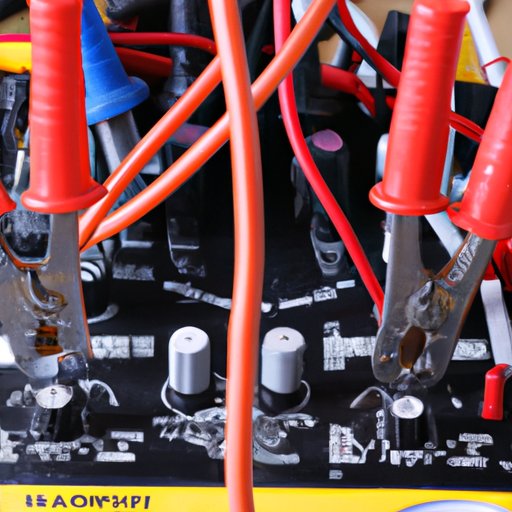Introduction
Your car battery is an essential component of your vehicle. It is responsible for providing electricity to all of the electrical components in your car, such as the starter motor, headlights, and other electrical accessories. Without a healthy battery, your car won’t start or run properly. That’s why it’s important to regularly check the health of your car battery by testing it with a multimeter.
A multimeter is an electronic device used to measure various electrical properties, such as voltage, current, and resistance. It is a handy tool for checking the health of your car battery, as it allows you to quickly and easily check the voltage of the battery and other important characteristics.
Check the Multimeter Readings for Voltage
The first step in testing your car battery with a multimeter is to check the voltage of the battery. Voltage is the amount of electrical pressure that is pushing current through the circuit. The higher the voltage, the more power the battery has to provide to the electrical components in your car.
To check the voltage of the battery, set the multimeter to the voltage setting and connect the positive lead to the positive terminal of the battery and the negative lead to the negative terminal of the battery. The multimeter will then display the voltage of the battery. If the voltage is below 12 volts, it is likely that the battery is failing and needs to be replaced.

Test the Battery with a Load Test
Once you have checked the voltage of the battery, it is time to perform a load test. A load test is designed to measure the ability of the battery to deliver a certain amount of current over a specified period of time. To perform a load test, set the multimeter to the load test setting and connect the leads to the battery terminals as before. The multimeter will then measure the current being delivered by the battery over a specific period of time.
If the battery is able to deliver enough current to power the electrical components in your car, the load test will be successful. If the battery fails the load test, it is likely that the battery is failing and needs to be replaced.

Measure the Alternator Output
The next step in testing your car battery with a multimeter is to measure the alternator output. The alternator is responsible for supplying power to the electrical components in your car when the engine is running. To measure the alternator output, set the multimeter to the voltage setting and connect the leads to the alternator terminals. The multimeter will then display the voltage of the alternator.
If the voltage is below 13.5 volts, it is likely that the alternator is not producing enough power to keep the battery charged. If this is the case, the alternator may need to be replaced.

Inspect the Battery Cables and Terminals
The next step in testing your car battery with a multimeter is to inspect the battery cables and terminals. Battery cables are responsible for carrying the electrical current from the battery to the electrical components in your car. Over time, these cables can become corroded or damaged, which can affect the performance of the battery.
To inspect the battery cables and terminals, disconnect them from the battery and inspect them for any signs of corrosion or damage. If any are found, replace them immediately. Once the cables and terminals are free from corrosion and damage, reconnect them to the battery.
Check the Battery’s State of Charge
The next step in testing your car battery with a multimeter is to check the battery’s state of charge. The state of charge is the amount of energy stored in the battery. To check the state of charge, set the multimeter to the voltage setting and connect the leads to the battery terminals. The multimeter will then display the voltage of the battery.
If the voltage is below 12 volts, it is likely that the battery is not fully charged and needs to be recharged. If the voltage is above 12 volts, the battery is likely in good condition and ready to be used.
Perform a Parasitic Draw Test
The final step in testing your car battery with a multimeter is to perform a parasitic draw test. A parasitic draw test is designed to measure the amount of current being drawn from the battery when the car is not running. To perform a parasitic draw test, set the multimeter to the current setting and connect the leads to the battery terminals. The multimeter will then display the amount of current being drawn from the battery.
If the amount of current being drawn from the battery is higher than expected, it is likely that there is an electrical component that is drawing too much current from the battery. If this is the case, the component should be inspected and repaired or replaced if necessary.
Conclusion
Testing your car battery with a multimeter is a quick and easy way to check the health of your car battery. By following the steps outlined in this article, you can easily check the voltage of the battery, perform a load test, measure the alternator output, inspect the battery cables and terminals, check the battery’s state of charge, and perform a parasitic draw test. These tests will help you determine the overall condition of your car’s battery and ensure that it is in good working order.
Remember to always check your car battery regularly and follow the manufacturer’s instructions for maintenance. Doing so will help to extend the life of your battery and keep your car running smoothly.


